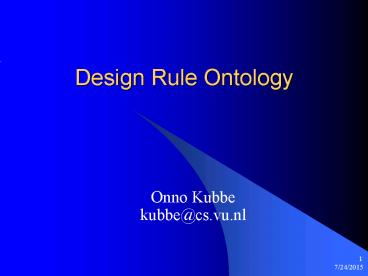Design Rule Ontology - PowerPoint PPT Presentation
Title:
Design Rule Ontology
Description:
Human-computer Interaction, A. Dix, J. Finlay, G.D. Abowd, R. Beal, 2004, chapter 7 pp. 258-287 ... pattern language for human-computer interaction: http://www. ... – PowerPoint PPT presentation
Number of Views:44
Avg rating:3.0/5.0
Title: Design Rule Ontology
1
Design Rule Ontology
- Onno Kubbe
- kubbe_at_cs.vu.nl
2
Introduction
- Design Rule Ontology definition of subject and
explanation - You will learn A vocabulary on design rules and
describe a problem with this vocabulary.
3
Overview
- Design Rules
- Principles
- Guidelines
- Standards
4
Standards
- Set by national or international bodies
- Hardware (e.g. ISO 9241)
- Theory physiology or ergonomics/human factors
- Software (e.g. ISO 14915)
- Theory psychology or cognitive science
- Change
- In hardware change is more set in stone vs
software easier to change
5
Guidelines
- Incompleteness of theories underlying design
makes it difficult to provide standards. - Solution create suggestive and general
guidelines. - Problems Level of abstraction
6
Principles
- Abstract design rules with high generality and
low authority - Learnibility
- Flexibility
- Robustness
7
Learnability
- Concerns the features of the interactive system
that allows novice users to understand how to use
it initially and then to attain a maximal level
of performance. - Predictability
- Synthesizability
- Familiarity
- Generalizability
- Consistency
8
Flexibility
- The multiplicity of ways in which the end-user
and the system exchange information - Dialog initiative
- Multi-threading
- Task migratability
- Substitutivity
- Customizability
9
Robustness
- In a work or task domain a user is engaged with a
computer to achieve some set of goals. The
robustness of that interaction covers features
that support the successful achievement and
assessment of the goals. - Observability
- Recoverability
- Responsiveness
- Task Conformance
10
Golden Rules and heuristics
- Shneidermans 8 golden rules of interface design
- Norman 7 principles for Transforming Diffictult
Tasks into simple ones
11
Excercise
- A windows XP design flaw? (handout)
- What design principles are violated in your
opinion and why. - Imagine you are a designer for Microsoft What
priority should repair have and why. - If you relate this ontology to the DUTCH design
method where can you use it in the process?
Motivate.
12
Summary
- What have we learned
- Questions
13
Literature
- Human-computer Interaction, A. Dix, J. Finlay,
G.D. Abowd, R. Beal, 2004, chapter 7 pp. 258-287
14
Design Patterns
- Onno Kubbe
- kubbe_at_cs.vu.nl
15
Introduction
- Design Patterns definition of subject and
explanation - You will learn how to use Design Patterns in your
project
16
Design Patterns
- Origin
- Architecture -gt computer science -gt HCI
- Why patterns
- To find an invariant solution to a recurrent
problem with a specific context - Formats
- Architecture quality without a name
- Computer Science re-use, flexibility and
efficiency of the sysem - HCI usability
17
Usability
- What is usability
- A stakeholders perspective
- A method of measuring usability
- The jump to HCI design patterns
18
A stakeholder perspective on usability
- Designer
- Engineer
- User
19
Usability indicators
- Learnability
- Memorability
- Speed of performance
- Error rate
- Satisfaction
- Task completion
20
A users perspective on Design Patterns
- A UID Design pattern should state the impact on
at least one of the usability indicators (more
refined def of design pattern) - Amsterdam Collection of UID Design Patterns
21
Pattern Languages
- What is a pattern Language
- - mental model
- Structure and organization
- Connecting patterns by
- Aggregation
- Specialization
- Association
22
A pattern language for Interaction Design
- Posture
- Purpose personal, social, commercial
- Experience
- Main user goals and tasks on a high level
- Task
- Solutions to small user problems that are part of
a higher level experience - Action
- Specific uses of well known widgets or describe
custom made widgets.
23
Examples
- Posture news site, portal
- Experience shopping, informing, browsing
- Task poll, forum, guided tour
- Action login, exit, choices
24
Excercises
- A website about dog cognition
- http//www.cs.vu.nl/ai/asr/Projects/dog-cognition
/index.html - What design patterns are used? Are they
connected someway? Is there a narrative here? - Motivate your answer.
- If you relate design patterns to the DUTCH design
method where can you use it in the process?
Motivate. - In your detailed design can you recognize
patterns that you use or can use? As always
motivate your answer.
25
Summary
- What have we learned
- How to
- Questions
26
Literature
- Patterns as tools for User Interface Design., van
Welie M., van der Veer G.C., Eliens A. - Breaking down usability, van Welie M., van der
Veer G.C., Eliens A. Proceedings of Interact 99,
Edinburgh Scotland - Pattern Languages in Interaction Design
Structure and Organisation, van Welie M., van der
Veer G.C., Interact 2003 - Wed design patterns, Mobile UI patterns,
http//www.welie.com (2006) - Common ground a pattern language for
human-computer interaction http//www.mit.edu/jt
idwell/common_ground_onefile.html - http//www.cs.kent.ac.uk/people/staff/saf/patterns
/gallery.html (2006)































